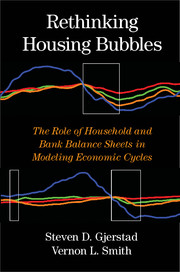 Rethinking Housing Bubbles
Rethinking Housing Bubbles Published online by Cambridge University Press: 05 June 2014
As explanations of the so-called business cycle, or cycles, when these are really serious, I doubt the adequacy of over-production,…over-confidence, over-investment, over-saving, over-spending, and the discrepancy between saving and investment. I venture the opinion…that in the great booms and depressions each of the above-named factors played a subordinate role as compared with two dominant factors, namely over-indebtedness to start with and deflation following soon after.
Over-investment and over-speculation are often important, but they would have far less serious results were they not conducted with borrowed money.
The same is true as to over-confidence. I fancy that over-confidence seldom does any great harm except when…it beguiles its victims into debt.
– Irving Fisher (1933, pp. 340–1)Interpretations of the Great Depression
Similarities between the financial crisis in September 2008 and the collapse of the financial system during the Great Depression are widely noted. Yet, the comparability of the origins and transmission of the crises have been neglected. The recent downturn, which originated with a pronounced housing boom and collapse, led to severe household balance sheet problems that were transmitted to lenders and mortgage security investors. Damage to household balance sheets weakened household demand – especially for housing and durable goods – which adversely affected employment, production, and nonresidential fixed investment. This pattern, however, is not recognized in the dominant view as a possible cause of the Great Depression. Contrary to prevailing views of its origins, we argue in this chapter that changes in the levels of mortgage finance and residential construction and the broader economy preceding and during the initial phases of the Great Depression shared many features with the recent Great Recession. Based on data collected by Wickens (1937), we estimate that by the end of the Great Depression, losses onmortgage loans exceeded estimates of losses in the Great Recession, either as a percentage of loans outstanding or as a percentage of aggregate output.
To save this book to your Kindle, first ensure no-reply@cambridge.org is added to your Approved Personal Document E-mail List under your Personal Document Settings on the Manage Your Content and Devices page of your Amazon account. Then enter the ‘name’ part of your Kindle email address below. Find out more about saving to your Kindle.
Note you can select to save to either the @free.kindle.com or @kindle.com variations. ‘@free.kindle.com’ emails are free but can only be saved to your device when it is connected to wi-fi. ‘@kindle.com’ emails can be delivered even when you are not connected to wi-fi, but note that service fees apply.
Find out more about the Kindle Personal Document Service.
To save content items to your account, please confirm that you agree to abide by our usage policies. If this is the first time you use this feature, you will be asked to authorise Cambridge Core to connect with your account. Find out more about saving content to Dropbox.
To save content items to your account, please confirm that you agree to abide by our usage policies. If this is the first time you use this feature, you will be asked to authorise Cambridge Core to connect with your account. Find out more about saving content to Google Drive.